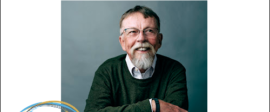A ‘Come and See’ Approach to Character Building
Blog / Produced by The High Calling
Scotland, Oregon, and the gift shop at CIA headquarters in Langley, Virginia, are only a few of the many places philosopher Steve Garber has seen the DEMDACO company’s iconic Willow Tree® giftware on display. The figurines are well-known to Garber not only because of their popularity and simple beauty, but also because of his consulting relationship with the Kansas City-based company.
In his work as director of the Washington Institute for Faith, Vocation, & Culture, Garber advises businesses on how to pursue a bottom line that involves more than just maximizing shareholder profits.
“We begin talking with honesty and integrity about not only being truly and meaningfully committed to making profit, but also to understanding our responsibility to people and to the planet. It can be complete rhetoric, of course, in the worse sense of that, but it also can be something for which there is honest buy-in, even if we’re not quite there yet,” Garber said.
Nurturing “coherence" is at the heart of Garber's work. In other words, he helps both individuals and organizations eliminate dissonance between what they say is important and what they do. With DEMDACO, he thinks through product lines and how best to communicate corporate values both within the company and externally.
On its website, DEMDACO says its mission is to provide uplifting products and to pursue the common good. Among its priorities are mutuality, restoring worth to work, and a strong play ethic because “work should also bring a sense of joy.” “These ethics resonate in DEMDACO’s commitment to human flourishing,” its mission statement says.
Values are transmitted in profound, yet simple ways, beginning with the design of DEMDACO's corporate headquarters. Garber described the space in an article on his organization's website. “The DEMDACO corporate center is a beautifully-imagined building of stone and glass. But as architecturally stunning as it is, the lobby offers a surprisingly graceful invitation: ‘Come and see who we are and what it is that matters to us,’” Garber wrote.
Two abstract paintings by the artist Makoto Fujimura are designed to explore “themes of business and life as they ought to be, the reality of the way they are, what we can do to help redeem them,” co-owner and CEO Dave Kiersznowski told Garber. And, a concierge welcomes guests warmly and offers refreshments while they wait.
 "Clearly what they have done in the company is taken the four-part story of creation, the fall, redemption, consummation and have infused that or woven that into the life of the company,” Garber told The High Calling. “They do have honest conversation about the way business ought to be,” not because DEMDACO is trying to be a Christian company but because they are “pursuing common grace for the common good."
"Clearly what they have done in the company is taken the four-part story of creation, the fall, redemption, consummation and have infused that or woven that into the life of the company,” Garber told The High Calling. “They do have honest conversation about the way business ought to be,” not because DEMDACO is trying to be a Christian company but because they are “pursuing common grace for the common good."
Meeting spaces throughout the building are named after “heroes of the common good” like Mother Theresa, Martin Luther King Jr., and William Wilberforce. Each room displays a sign explaining the person’s work and its importance. “These are simple reminders meant to help DEMDACO’s employees remember the meaning of their work, that in their labour they are doing something that matters,” Garber wrote.
Some years ago, Garber was asked to craft an explanation of DEMDACO's view of creativity for the artists who design its products. The document said that although the company is not Christian, its owners Dave and Demi are and their faith shapes their corporate vision.
Last year, Garber was asked to consult on a situation in which a product line was out of sync with this vision. In conversations about the issue, he talked to an executive who had worked at another company for most of her life and has been at DEMDACO for only a few years.She said DEMDACO leaders “would never make a disparaging remark about somebody who works in the packaging or warehouse division, because that just would never, ever go here.This attitude was a marked change from what she had seen at her previous place of employment, where there was division between white and blue-collar workers. “You’re expected here to honor everybody else,” the woman told Garber.
Like Jim Gentry and Glenn Barnett, who were interviewed for our previous article on the role of character in leadership, Garber says values must be both proclaimed and modeled.
“I do fundamentally believe in what I would call the ‘come-and-see pedagogy,’ which is language that I’ve taken from John, chapter 1,” said Garber. “The most important things we learn, we only learn looking over the shoulders and through the heart. … But I would also say there is something about context and paradigm, which is important.”
As Gentry and Barnett both noted, it can be more difficult for an employee in an ethically compromised organization to pursue a virtuous bottom line, but it’s not impossible. Individuals and organizations each have a role to play in nurturing coherence between words and deeds.
“In some ways, [high corporate values] have to be bought into. There has to be integrity on the part of the leadership, whether it’s a nation, a corporation, a church, a foundation, or a school. But there has to be buy-in too. There has to be, ‘Well, I get that. I understand that. That makes sense to me. I believe that too,’” said Garber.
Feature image by Defence Images. Used with permission. Sourced via Flickr. Post and Willow Tree® image by Christine A. Scheller.





